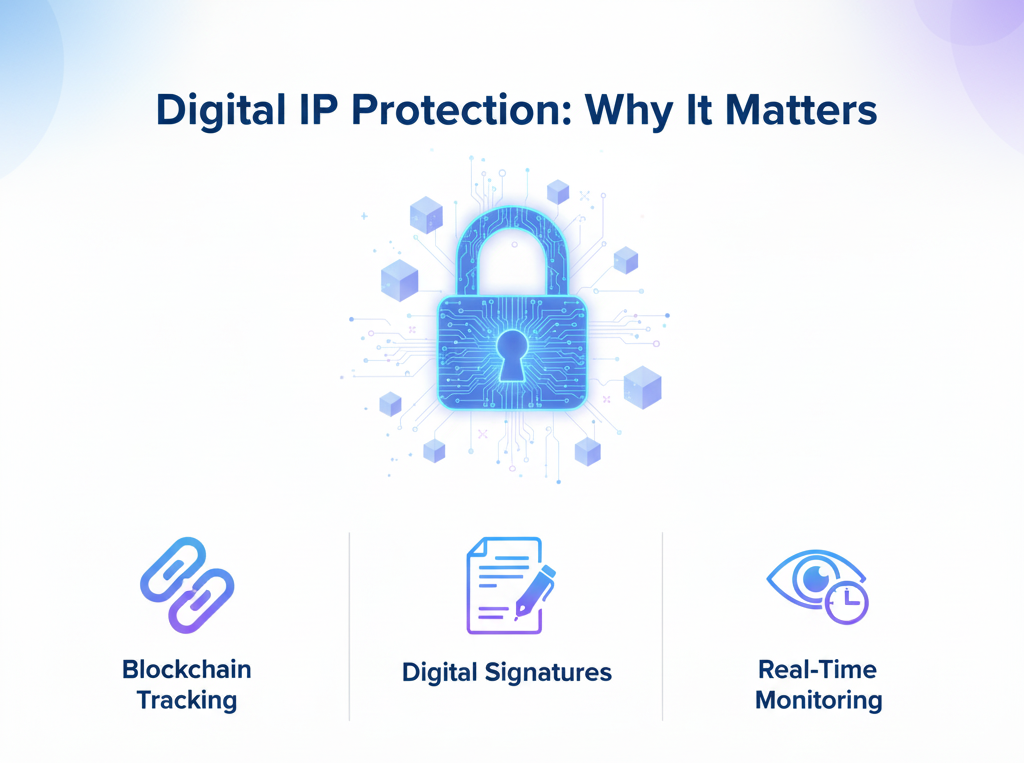In today’s world, almost every business has gone digital. From startups sharing innovative ideas online to global brands selling products across borders, the internet has opened up endless opportunities. But with opportunity comes risk.
Your intellectual property (IP) – designs, software, content, brand identity – can be stolen in seconds
A copied logo, pirated software, or stolen digital asset can destroy years of hard work, damage your reputation, and cause massive financial losses.
That’s why digital IP protection is no longer a “nice-to-have.” It’s a business necessity.
In this article, we’ll explore:
-
Why digital IP is more vulnerable than ever
-
The real risks businesses face today
-
Proven strategies to protect your IP online
-
How blockchain, digital signatures, and AI-powered monitoring can change the game
-
What the future of digital IP protection looks like
By the end, you’ll know exactly how to safeguard your business in the digital era.
Why Digital IP Protection Matters More Than Ever
Traditional IP protection (like trademarks, patents, and copyrights) still matters – but in a borderless digital economy, they’re not enough on their own.
Here’s why:
-
Speed of theft → A design uploaded today can be copied, reposted, and sold worldwide by tomorrow.
-
Global reach → Infringers can operate from any country, making legal action harder.
-
Digital-first businesses → For many startups, their IP is their entire value (apps, platforms, software, media).
-
Investor trust → Serious investors want proof that your digital assets are protected before funding growth.
In short, unprotected IP = business risk.
The Real Risks of Digital IP Theft
Let’s break down some common threats businesses face today:
1. Content Piracy
Your eBooks, online courses, videos, or designs can be illegally copied and distributed without credit.
2. Software Theft
Pirated versions of your app or SaaS product can circulate online — cutting into revenue and damaging your brand.
3. Brand Identity Misuse
Fake websites or social media accounts can impersonate your brand, mislead customers, and steal data.
4. Counterfeit Products
E-commerce sellers may copy your product designs, packaging, or branding to sell cheap replicas.
5. Data Breaches
Sensitive IP files can be hacked, leaked, or sold on the dark web.
📌 According to reports, global IP theft costs businesses over $600 billion annually. That’s not just big corporations – SMEs and startups are often the easiest targets.
How to Protect Your Digital IP
Now let’s dive into the three most effective strategies to secure your digital assets.
✅ 1. Blockchain Tracking
Blockchain isn’t just for crypto – it’s a powerful tool for IP.
How it works:
-
Every time you create something (a design, code, or document), you can timestamp it on the blockchain.
-
This creates a permanent, tamper-proof record of ownership.
-
If someone tries to claim your work as theirs, you have undeniable proof of originality.
🔹 Example: A graphic designer uploads their portfolio and timestamps each file on blockchain. If a company steals a design, the blockchain record shows who created it first.
Benefits:
-
Transparent and secure ownership records
-
Easy to prove originality in disputes
-
Builds trust with clients and investors
2. Digital Signatures
Think of digital signatures as your work’s fingerprint.
How it works:
-
A unique digital code is embedded into your file.
-
If anyone tries to copy, modify, or redistribute it without permission, the signature reveals the infringement.
🔹 Example: An author adds a digital signature to their eBook. Even if pirated versions appear online, the embedded code traces it back to the source.
Benefits:
-
Protects documents, images, software, and media
-
Difficult to remove or tamper with
-
Adds an extra layer of authenticity
3. Real-Time Monitoring
This is where AI steps in.
How it works:
-
Automated tools scan websites, marketplaces, and social media for copies of your IP.
-
You get alerts when suspicious use is detected.
-
You can take quick action (DMCA takedown, legal notice, etc.).
🔹 Example: A fashion brand uses monitoring software to track e-commerce sites. It finds counterfeit sellers using their photos and files reports immediately.
Benefits:
-
24/7 online protection
-
Saves time compared to manual searching
-
Reduces financial and reputational damage
Beyond Tech: Legal & Business Steps
While blockchain, signatures, and monitoring are powerful, you should also combine them with legal protections:
-
Register your IP → Trademark your brand name and logo. Copyright your content. Patent your inventions.
-
Use contracts & NDAs → Protect sensitive information when working with partners, freelancers, or employees.
-
Educate your team → Ensure employees understand IP policies and risks.
-
Act quickly → The faster you respond to infringement, the less damage it can do.
The Future of Digital IP Protection
The next few years will see major advancements in how we protect digital assets:
-
AI-powered enforcement → Smarter detection systems will find and remove stolen content automatically.
-
Global blockchain registries → Standardized platforms to record and verify IP ownership across industries.
-
Smart contracts → Licensing and royalties handled automatically when someone uses your IP.
-
Metaverse IP challenges → Virtual goods and NFTs will require entirely new protection frameworks.
Businesses that adopt these tools early will stay ahead of infringers and build stronger global brands.
Final Thoughts
In the digital era, your IP isn’t just legal paperwork – it’s the core of your business value.
Without protection, you risk losing revenue, reputation, and opportunities.
With protection, you gain trust, security, and freedom to grow.
👉 Ready to secure your digital assets?
Send me a message with the word “DIGITAL” and I’ll share a free step-by-step guide to help you get started.
Because at the end of the day:
Innovation deserves protection.



